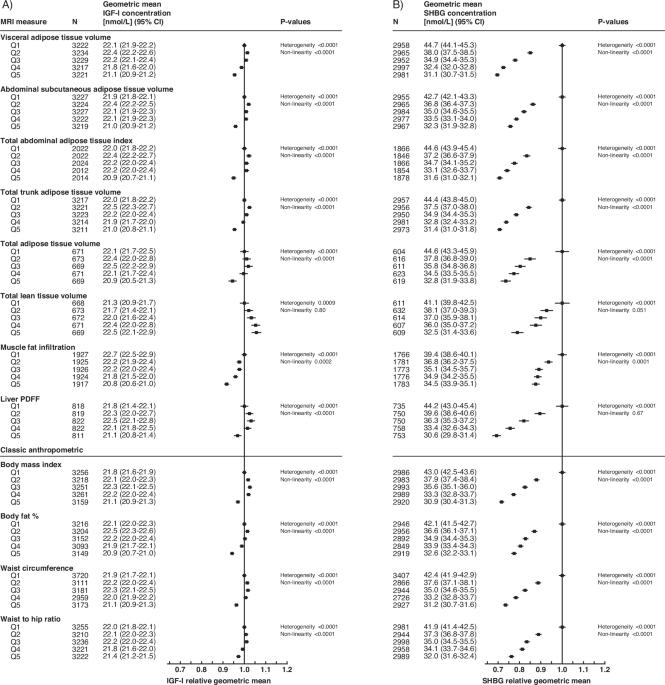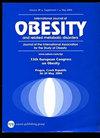16,000 名男性的身体成分测量与循环胰岛素样生长因子-I、睾酮和性激素结合球蛋白浓度的关系。
IF 4.2
2区 医学
Q1 ENDOCRINOLOGY & METABOLISM
引用次数: 0
摘要
背景:肥胖与男性罹患某些癌症和其他健康问题的风险呈正相关;然而,内源性激素是否在这些关联中发挥作用尚不清楚。我们研究了磁共振成像(MRI)测量的身体成分和常见的肥胖测量方法(如体重指数(BMI))与英国生物库研究中男性体内激素浓度的关系:方法:研究人员纳入了多达 16,237 名男性,这些男性具有可用的身体成分数据(包括内脏脂肪、皮下脂肪、肝脏脂肪、肌肉脂肪浸润(MFI)、瘦肉组织和常见的脂肪测量指标)和血清激素测量指标(胰岛素样生长因子-I(IGF-I)、总睾酮、性激素结合球蛋白(SHBG)和游离睾酮计算值)。采用多变量调整线性回归模型来确定每种暴露类别中激素和 SHBG 浓度的几何平均数:结果:常见的脂肪测量值与 MRI 测量的中心脂肪和总脂肪高度相关(r = 0.76-0.91),但与异位脂肪(肝脏脂肪和 MFI)的相关性较低(r = 0.43-0.54)。大多数脂肪测量值与循环 IGF-I 和游离睾酮呈 U 型或 J 型反向相关;然而,MFI 呈线性反向相关,而瘦组织体积与 IGF-I 和游离睾酮浓度呈正相关。所有身体组成指标均与总睾酮和 SHBG 浓度成反比(Q5 与 Q1 之间的相对几何平均差异:20%-30%):我们的研究结果表明,普通脂肪和大多数 MRI 脂肪测量值与血清激素浓度的关系相似;但与异位脂肪(尤其是 MFI)和瘦肉组织的关系却不同。本文章由计算机程序翻译,如有差异,请以英文原文为准。

Associations of body composition measures with circulating insulin-like growth factor-I, testosterone, and sex hormone-binding globulin concentrations in 16,000 men
Adiposity is positively associated with risk of some cancer sites and other health conditions in men; however, it is unclear if endogenous hormones play a role in these associations. We examined how body composition, measured from magnetic resonance imaging (MRI) and common measures of adiposity (e.g., body mass index (BMI)), are related to hormone concentrations in men from the UK Biobank study. Up to 16,237 men with available body composition data (including visceral, subcutaneous, and liver fat, muscle fat infiltration (MFI), lean tissue, and common adiposity measures) and serum hormone measurements (insulin-like growth factor-I (IGF-I), total testosterone, sex hormone-binding globulin (SHBG), and calculated free testosterone) were included. Multivariable-adjusted linear regression models were used to determine the geometric mean hormone and SHBG concentrations across categories of each exposure. Common measurements of adiposity were highly correlated with MRI measures of central and total adiposity (r = 0.76–0.91), although correlations with ectopic fat (liver fat and MFI) were lower (r = 0.43–0.54). Most adiposity measurements showed an inverse U- or J-shaped association with circulating IGF-I and free testosterone; however, MFI was linearly inversely associated, and lean tissue volume was positively associated with both IGF-I and free testosterone concentrations. All body composition measures were inversely associated with total testosterone and SHBG concentrations (relative geometric mean difference between Q5 vs. Q1: 20–30%). Our results show that common adiposity and most MRI measures of adiposity relate similarly to serum hormone concentrations; however, associations with ectopic fat (particularly MFI) and lean tissue were different.
求助全文
通过发布文献求助,成功后即可免费获取论文全文。
去求助
来源期刊

International Journal of Obesity
医学-内分泌学与代谢
CiteScore
10.00
自引率
2.00%
发文量
221
审稿时长
3 months
期刊介绍:
The International Journal of Obesity is a multi-disciplinary forum for research describing basic, clinical and applied studies in biochemistry, physiology, genetics and nutrition, molecular, metabolic, psychological and epidemiological aspects of obesity and related disorders.
We publish a range of content types including original research articles, technical reports, reviews, correspondence and brief communications that elaborate on significant advances in the field and cover topical issues.
 求助内容:
求助内容: 应助结果提醒方式:
应助结果提醒方式:


